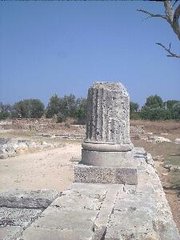Locri
|
|
Street.jpg
Locri Epizephyri (epi-Zephyros, under the West wind) was founded about 680 BC on the Italian shores of the Ionian Sea, near modern Capo Zefirio, by the Locrians, apparently by Opuntii (East Locrians) from the city of Opus, but including Ozolae (West Locrians) and Lacedaemonians. (But Strabo suggests that it was the Ozolae who were the main founders.)
Due to hard winds at the original location of settlement, they moved to the present Locri site, where the city was founded. After a century, a wall around the city was created from large blocks. Outside the city there are several necropoleis, some of which are very large.
Epizephyrian Locri was one of the more important cities of the Magna Graecia. It was renowned for its lawgiver Zaleucus, who provided that anyone who decreed that anyone who proposed a change in his laws should do so with a noose about his neck, with which he should be hanged if the amendment did not pass. Plato called it "The flower of Italy", due to the local peoples' characteristics.
In the early centuries Locri was allied with Sparta, and later with Syracuse. It founded two colonies of its own, Hipponion and Medma.
It was a substantial town, allied to Rome in the time of Polybius. It was abandoned in the 5th century AD. and finally destroyed by the Saracens.
Ionic temple of Marasà
In the first half of 5th century BC, the Locrians destroyed the archaic temple and rebuilt a new temple in the Ionic style. The temple was designed by Syracusean architects around 470 BC based on the idea of Hiero I of Syracuse.
The new temple has the same place as the previous one but it has a different orientation. The temple was destroyed in the 11th century. The dimensions of the temple were 45.5 meters x 19.8 meters. The cell is free by supports on the central axes. The pronaos had two columns. The temple has 17 ionic columns on the long side, and 6 on the front. The height of the temple was 12 meters.
The theater
The theater has been built not far from the ancient city, in the Contrada Pirettina. It was dug in a beautiful place, in order to take advantage of the hills. The theater was built in the IVth century b.c. The original structure had space for more than 4,500 people, now it is visible only the central part of the theater. Part of the Cavea (Koilon in Greek) was cut in the rocks. Each plane was divided in 7 wedges Kerkìdes between 6 scales Klimakes. An horizontal separation Diazoma divided the upper theater Epitheatron from the lower theater.de:Locri it:Locri


